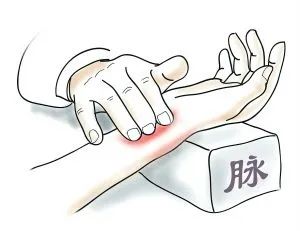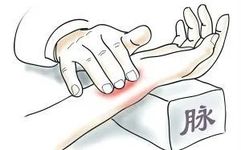

Comprehensive TCM Classics >>>【TCM Treasure】 Mobile App: Free Download + Free Use


The deep pulse (沉脉, chén mài) has two meanings: one refers to its location, which is characterized by being felt only upon heavy pressure to the bones and muscles, regardless of its size, speed, or strength; the other refers to a specific type of pulse with strict characteristics. To differentiate, the former can be called “pulse deep” (脉沉, mài chén), while the latter is referred to as “deep pulse” (沉脉, chén mài).
A normal deep pulse is characterized by being insufficient when lifted and excessive when pressed, resembling sand wrapped in cotton, firm inside yet soft outside. In addition to being located deep, it must also exhibit the characteristics of being “soft, slippery, and even.” Soft and even indicate a relaxed appearance within the deep pulse, with a smooth and even flow, reflecting the presence of stomach qi. The deep and slippery pulse indicates the yin aspect (沉, chén) and the yang aspect (滑, huá), symbolizing yang submerged in water, representing the harmonious pulse of winter and the kidneys.
The deep pulse is a very important pulse, as it serves as the foundation and root of pulse diagnosis. The pulse is governed by the concepts of deficiency and excess, and the distinction between these states is based on the strength or weakness of the deep pulse. Therefore, the deep pulse is extremely significant.
What causes the pulse to be deep? It is due to the inability of qi and blood to express outwardly, leading to a deep pulse.
Why is qi and blood unable to express outwardly? There are two main reasons: one is the deficiency of righteous qi, resulting in the inability of qi and blood to express outwardly, leading to a deep pulse; the other is the obstruction of pathogenic qi, which blocks the pathway for qi and blood to express outwardly, also resulting in a deep pulse.
1. Deficiency leading to a deep pulse
A deep pulse due to deficiency can be seen in conditions of yang deficiency, qi deficiency, blood deficiency, and yin deficiency. Yang is active and can stimulate and activate the functions of the entire body. When yang is deficient, it cannot effectively promote the circulation of qi and blood, resulting in a deep pulse. Qi acts as a bellows, propelling blood through the vessels. When qi is deficient, it cannot effectively propel, hence the pulse is deep. In cases of blood deficiency, there is insufficient filling of the vessels, leading to a deep pulse. Moreover, blood deficiency often accompanies qi deficiency, resulting in both qi and blood being insufficient, causing the pulse to lose its fullness and propulsion, thus becoming deep. In cases of yin deficiency, the vessels may also lack fullness, leading to a deep pulse. In deficiency, the pulse is deep yet weak.
When encountering a deep and weak pulse in clinical practice, the nature of the illness is undoubtedly one of deficiency. However, determining whether it is due to yang deficiency, qi deficiency, blood deficiency, or yin deficiency requires a comprehensive analysis based on the accompanying pulses and the three diagnostic methods of observation, listening, and inquiry. In cases of yang deficiency, the pulse is deep, slow, and weak, accompanied by symptoms of cold limbs, pale tongue, and slippery coating. In cases of qi deficiency, the pulse is deep and weak, accompanied by shortness of breath and weakness. In cases of blood deficiency, the pulse is deep, thin, and weak, accompanied by a pale complexion, palpitations, and a pale, tender tongue. In cases of yin deficiency, the pulse is deep, thin, and rapid, accompanied by symptoms of deficiency heat and a red tongue with little coating.
In the previous lesson on the floating pulse, we mentioned that deficiency can lead to a floating pulse, and here we state that deficiency can also lead to a deep pulse. Is this contradictory? Not at all. Deficiency can manifest as either a deep or floating pulse, depending on the degree and nature of the deficiency. In cases of yang deficiency, if the deficiency is not severe, the pulse may be deep yet weak; however, if yang deficiency leads to a rejection of yin and yang, causing yang qi to escape outward, the pulse may transition from deep and weak to floating, large, rapid, and scattered. If yang deficiency worsens further, even the ability to float may be lost, resulting in the pulse becoming deep, thin, and almost imperceptible, or even absent. In cases of mild qi deficiency, the pulse may not withstand heavy pressure or may feel weak upon pressure. If qi deficiency is accompanied by internal heat, the qi and blood may float outward due to the heat, resulting in a large, rapid pulse. In cases of severe qi deficiency, the pulse may float and scatter, or it may become deep, thin, and almost imperceptible. Since blood is the mother of qi, blood deficiency often accompanies varying degrees of qi deficiency. When both qi and blood are insufficient, they cannot effectively propel blood through the vessels, leading to a deep, thin, and weak pulse. If blood deficiency cannot contain itself, qi may float outward, resulting in a large, weak pulse. Especially when blood is lost rapidly, qi escapes outward, presenting with a large, hollow pulse. In cases of yin deficiency, if yang qi has not yet floated outward, the pulse often presents as deep, thin, and rapid. If yin deficiency is more severe, and yin cannot contain yang, leading to yang floating outward, the pulse may present as floating, large, rapid, or as a pulse that is strong above and weak below, indicating a strong yang and weak yin. Therefore, in cases of deficiency, the pulse can be either deep or floating, depending on the degree and nature of the deficiency.
2. Obstruction leading to a deep pulse
Obstruction of qi and blood due to internal and external pathogens can lead to a deep pulse, including the six excesses, seven emotions, and issues related to qi, blood, phlegm, and food.
1. The six excesses can lead to a deep pulse. It is commonly said that a floating pulse indicates an exterior condition, and exterior conditions typically present with a floating pulse. However, upon careful observation in clinical practice, it is often found that at the onset of an exterior condition, the pulse may not be floating but rather deep. This is particularly true for individuals with a deficiency of righteous qi. However, even in healthy individuals, the pulse may not be floating at the onset of an exterior condition. The reason for this is that pathogenic qi obstructs the flow.
When an exterior cold pathogen invades the skin, its nature is to condense and obstruct, leading to a blockage of the pores and stagnation of the meridians, preventing qi and blood from expressing outwardly, resulting in a deep pulse. As stated in the “Four Diagnostic Methods”: “When the exterior cold is severe, yang qi cannot express outwardly, and the pulse must first be seen as deep and tight.” It is also stated, “Is it possible for cold to close the pores, causing both nutritive and defensive qi to stagnate, and the pulse to not be deep?”
In the early stages of a warm disease, when the pathogen invades the lung and the defensive qi is affected, the pulse should be floating. Since the warm pathogen is a yang pathogen, it should express outwardly, and the pulse should be floating. However, in clinical practice, it is often found that at the onset of a warm disease, the pulse is also often deep. Why is the pulse deep at the onset of a warm disease? Because the warm pathogen first affects the lung, leading to stagnation of lung qi.
Stagnation refers to the obstruction of qi flow. The warm pathogen obstructs the lung, causing heat, and the defensive yang fails to express outwardly, leading to a deep pulse. Thus, even at the onset of a warm disease, a deep pulse is understandable. This indicates that the deep pulse can also indicate an exterior condition.
Of course, it is not that exterior conditions do not present with a floating pulse. When the external pathogen transforms into heat, the heat expands and promotes the outward expression of qi and blood, resulting in a floating pulse. If the heat becomes excessive, qi and blood may be forced outward by the heat, resulting in a pulse that is not only floating but also large and rapid. At this point, the condition has progressed from the taiyang stage to the yangming stage, or from the defensive stage to the qi stage.
A floating pulse indicating an exterior condition seems to be an unchanging conclusion. Therefore, whether the pulse is floating or deep has become a major criterion for determining the presence of an exterior condition. However, through the above discussion, it is clear that at the onset of an exterior condition, the pulse may not be floating. So how should we determine the presence of an exterior condition? The main indicators for determining the presence of an exterior condition should be the presence of aversion to wind and cold. The more aversion to cold, the more likely there is an exterior condition. Of course, both heat and yang deficiency can also cause aversion to cold, but this is different from the aversion to wind and cold seen in exterior conditions. The aversion to wind and cold in exterior conditions must meet the following characteristics: first, there is aversion to wind and cold at the onset of the illness; second, aversion to cold and fever occur simultaneously; third, if the exterior condition does not resolve, the aversion to wind and cold will not disappear; fourth, aversion to cold and fever occur simultaneously, accompanied by symptoms such as body aches, nasal congestion, and cough. If these characteristics of aversion to wind and cold are present, then an exterior condition exists; if these characteristics are absent, then no exterior condition exists. Therefore, the presence or absence of an exterior condition should not be based solely on whether the pulse is floating or deep.
2. Emotional disturbances can lead to a deep pulse. Emotional disturbances disrupt the flow of qi, preventing qi and blood from circulating smoothly, resulting in a deep pulse. Within a deep pulse, there may also be characteristics of fullness, wiriness, thinness, roughness, slowness, knots, etc. The appearance of these different pulse characteristics stems from the same pathological mechanism, which is due to qi stagnation preventing the smooth flow of qi and blood. Due to varying degrees of stagnation and differences in the strength of righteous qi, different pulse characteristics may appear.
3. Phlegm, dampness, stasis, food stagnation, water retention, accumulation, fullness of the bowels, and heat stagnation can all obstruct the flow of qi, leading to a deep pulse. Due to the different types of obstructive pathogens, the degree of obstruction varies, and the deep pulse may also exhibit characteristics such as slippery, wiry, thin, soft, rough, full, knotty, or even hidden or replete. Since these all belong to the category of pathogenic excess, they are all deep and strong.
High-definition tongue diagnosis atlas (for collection)
Follow our public account:TCM Treasure Xinglin Medical Classics Qihuang Treasure Suspended Pot Treasure Traditional Chinese Medicine
★ The above content is for reference only; if you have any physical discomfort, please visit a regular hospital for treatment.★
-
The chest is half a woman’s life!
-
In summer, can we really indulge in cold drinks?
-
Are nodules and polyps cancerous? Should they be treated? This article explains everything!
-
Mr. Li Hanqing’s tongue diagnosis insights
-
Why is it sometimes so difficult to “reduce a fever”? Distinguishing between deficiency and excess is very important!
-
Strange phenomena in TCM practitioners: “I dare not prescribe medicine, nor dare to use formulas!”
-
In the debate: Who is the real culprit behind the decline of TCM?
-
20 uses of Xiao Chai Hu Decoction, TCM’s “anti-inflammatory drug”
-
Does crossing your legs “kill sperm”? After reading these 6 terrifying consequences, I quickly sat up straight.
-
A speech that left the audience in silence (about medicine, hospitals, and doctors)!
-
Uterine fibroids do not necessarily need to be “surgically removed”; TCM moxibustion and dietary therapy have remarkable effects.
-
Opening the organs of the deceased revealed that 300 million people are quietly spending money to die!
-
A precious illustration of Hua Tuo’s “Five Animal Play” spanning thousands of years!
-
Unveiling the mystery! How powerful is the miraculous Zhu You technique?
-
TCM encompasses the universe, while Western medicine lacks a holistic view.
Purchase physical TCM textbooks:
-
Online purchase of TCM textbooks【Part One】
-
Online purchase of TCM textbooks【Part Two】
-
Online purchase of acupuncture-related textbooks【Part Three】
-
Online purchase of TCM massage-related textbooks【Part Four】
-
Read online: “How Many Autumn Chills in TCM”
-
Read online: “The TCM Stories of a Grandfather and Grandson” (A Young Doctor’s Medical Journey)
TCM Video Tutorials
More content can be found in the 【TCM Treasure】 article ranking summary >>>


